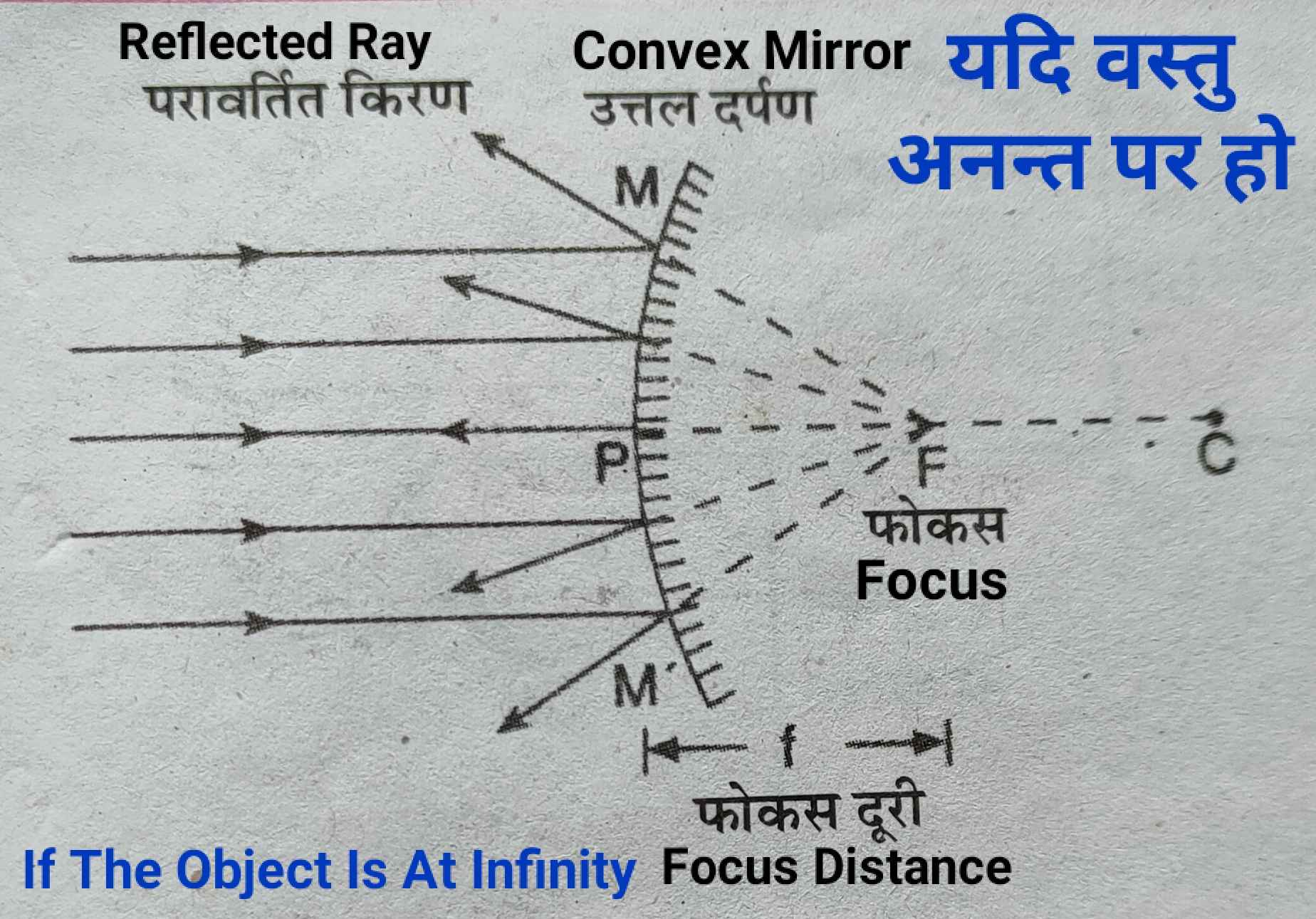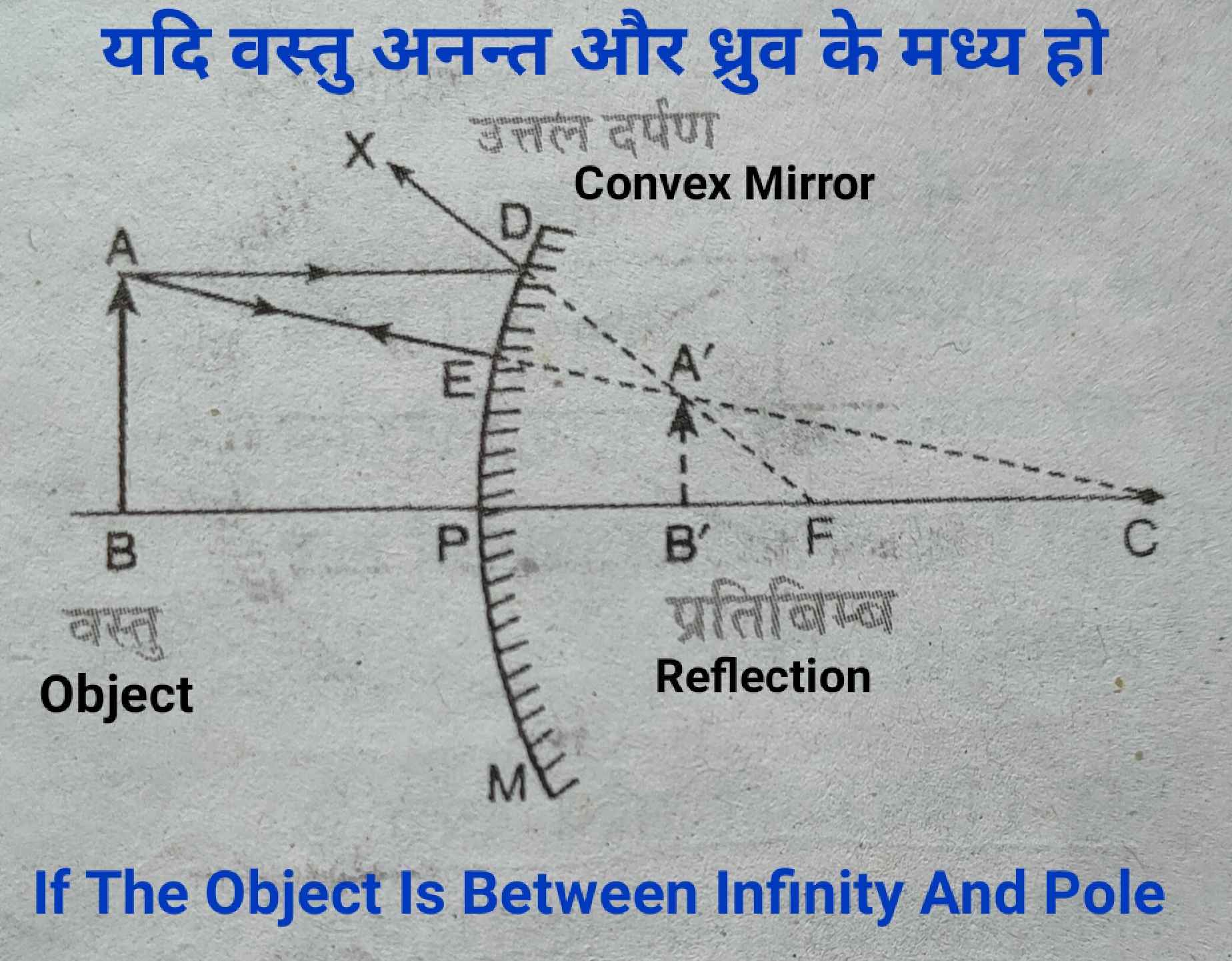
उत्तल दर्पण में प्रतिबिम्ब किस प्रकार बनते हैं? | How Are Images Formed In A Convex Mirror?
उत्तल दर्पण में प्रतिबिम्ब रचना के तथ्य (Facts Of Image Formation In A Convex Mirror)
उत्तल दर्पण में प्रतिबिम्ब की स्थिति को निर्धारित करने के लिए निम्नलिखित नियमों का प्रयोग किया जाता है–
1. उत्तल दर्पण पर जो प्रकाश किरणें मुख्य अक्ष के समान्तर आपतित होती हैं, वे परावर्तन के पश्चात् फोकस से आती हुई प्रतीत होती हैं।
2. जो प्रकाश किरणें उत्तल दर्पण के वक्रता केन्द्र की दिशा से चलकर दर्पण पर आपतित होती हैं, परावर्तन के पश्चात् वे किरणें उसी मार्ग से वापस लौट जाती हैं।
3. उत्तल दर्पण में जो प्रकाश किरणें फोकस से दर्पण की ओर आपतित होती हैं, वे परावर्तन के बाद मुख्य अक्ष के समान्तर हो जाती हैं।
The following rules are used to determine the position of the image in a convex mirror–
1. The rays of light which are incident on a convex mirror parallel to the principal axis, they appear to come from the focus after reflection.
2. The light rays which travel from the direction of the center of curvature of the convex mirror and incident on the mirror, after reflection, those rays return through the same path.
3. In a convex mirror, the rays of light which are incident from the focus to the mirror become parallel to the principal axis after reflection.
भौतिक विज्ञान के इन 👇 प्रकरणों को भी पढ़ें। (Also read these 👇 episodes of Physics.)
अवतल दर्पण में प्रतिबिम्ब किस प्रकार बनते हैं? | How Are Images Formed In Concave Mirror?
उत्तल दर्पण से सम्बन्धित प्रतीक (Convex Mirror Symbol)
उत्तल दर्पण से सम्बन्धित कुछ महत्वपूर्ण परिभाषाओं के संकेत निम्नलिखित हैं–
1. वक्रता केन्द्र = C
2. वक्रता त्रिज्या = R
3. ध्रुव = P
4. फोकस = F
The following are the indications of some important definitions related to a convex mirror–
1. Center of curvature = C
2. Radius of curvature = R
3. Pole = P
4. Focus = F
भौतिक विज्ञान के इन 👇 प्रकरणों को भी पढ़ें। (Also read these 👇 episodes of Physics.)
गोलीय दर्पण क्या है? | अवतल और उत्तल दर्पण || What Is Spherical Mirror? | Concave And Convex Mirror
उत्तल दर्पण में प्रतिबिम्ब बनना (Image Formation In A Convex Mirror)
उत्तल दर्पण में वस्तु की विभिन्न स्थितियों में प्रतिबिम्ब के निर्माण को इस प्रकार समझा जा सकता है–
The formation of image in different positions of the object in a convex mirror can be understood as–
भौतिक विज्ञान के इन 👇 प्रकरणों को भी पढ़ें। (Also read these 👇 episodes of Physics.)
दर्पण किसे कहते हैं? | समतल दर्पण में प्रतिबिम्ब कैसे बनता है? || Information About Plane Mirror

यदि वस्तु अनन्त पर हो (If The Object Is At Infinity)
यदि वस्तु अनन्त पर हो, तो उत्तल दर्पण में उसका प्रतिबिम्ब फोकस पर बनता है। यह प्रतिबिम्ब दर्पण के पीछे बनता है। इसका आकार अत्यधिक छोटा (लगभग बिन्दु के समान) होता है। प्रतिबिम्ब की प्रकृति आभासी होती है और वह सीधा बनता है।
If the object is at infinity, then in a convex mirror its image is formed at the focus. This image is formed behind the mirror. Its size is very small (almost like a point). Image is virtual in nature and it is formed upright.
भौतिक विज्ञान के इन 👇 प्रकरणों को भी पढ़ें। (Also read these 👇 episodes of Physics.)
प्रकाश का परावर्तन एवं इसके नियम | Reflection Of Light And Its Laws

यदि वस्तु अनन्त और ध्रुव के मध्य हो (If The Object Is Between Infinity And Pole)
यदि वस्तु अनन्त और ध्रुव के मध्य स्थित हो, तो उत्तल दर्पण में उसका प्रतिबिम्ब ध्रुव और फोकस के मध्य बनता है। यह प्रतिबिम्ब दर्पण के पीछे बनता है। इसका आकार वस्तु के आकार से छोटा होता है। प्रतिबिम्ब की प्रकृति आभासी होती है और वह सीधा बनता है।
If the object is situated between infinity and pole, then in convex mirror its image is formed between pole and focus. This image is formed behind the mirror. Its size is smaller than the size of the object. Image is virtual in nature and it is formed upright.
रसायन विज्ञान के इन 👇 प्रकरणों को भी पढ़ें। (Also read these 👇 episodes of Chemistry.)
साबुन और अपमार्जक कैसे सफाई करते हैं? | How Do Soaps And Detergents Clean?
आशा है, उपरोक्त जानकारी उपयोगी एवं महत्वपूर्ण होगी।
(I hope the above information will be useful and important. )
Thank you.
R. F. Tembhre
(Teacher)
pragyaab.com




Comments